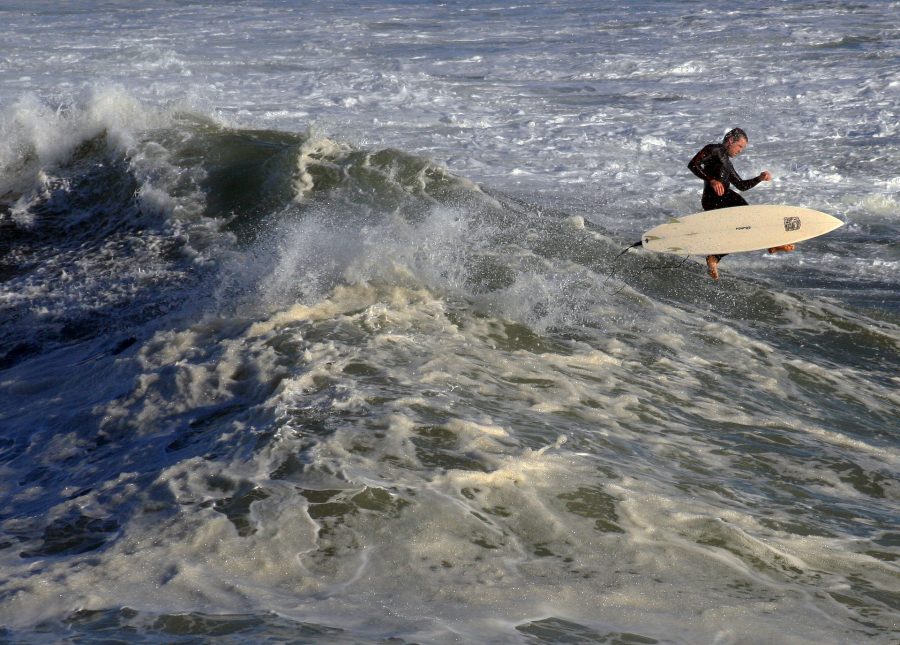So, you’re out to catch the perfect wave but afraid of looking like a Barney? Don’t even know what a Barney is? Don’t worry, continue reading and you’ll learn about the basics of surfing, essential gear to grab before you head out, and some surf etiquette.
Surfing can be a very fun and liberating experience, but it can also be dangerous if you don’t know what you’re doing. Below is everything you need to know about surfing before you even get into the water.
Know What Equipment to Get
Starting out surfing, you will essentially need four things: A board (of course,) a wetsuit rash guard, wax, and a leash. For a beginner, a longer, foam board is recommended. The bigger the board, the easier it is to maneuver in the water. Foam gives your board more buoyancy so it’s easier to stay on top of the waves. Also, foam is much more forgiving than a fiberglass or epoxy surfboard. It is a much safer material not only for you, but for the other surfers out there. While surfing you will wipeout, and wiping out on foam is much more enjoyable than fiberglass or epoxy.
A wetsuit or rash guard will serve multiple purposes when out in the water. A wetsuit can keep you warm in colder water, while a rash guard can be worn by itself in warmer conditions or under a wetsuit. Whatever the conditions may be, a wetsuit or rash guard also will protect you from scrapes, cuts, stings, and everything else that might rough you up below the water. Above the water, a wetsuit or rash guard will act as an extra level of protection from the sun, minimizing exposure to UV rays and sunburn.
You will want wax to apply to the deck, or top, of your surfboard. It will prevent you from slipping while you are paddling or standing on your board. You’ll want to apply wax to your board every time before surfing, unless you have a deck grip. There are many waxes out there, but they all basically do the same thing—keep your feet and body from slipping off the board when paddling or standing.
When you take a spill on your board—and you will—it is important to be wearing a leash for a variety of reasons. Leashes are basically just a rope that tethers you to your surfboard. When you fall, your board can take off on you and a leash attached to your ankle will eliminate the risk of your runaway board hitting and injuring another surfer. Another good reason to be attached to your board is that you can be tired and become disorientated under water when you fall. It is smart and comforting to be attached to something that floats.
Learn the Basics On Land
Now that you’ve got all your gear, it’s time to get out into the water, right? Wrong! Next, you will need to learn which stance you are comfortable with on the board. You will need to learn how to sit on a surfboard, how to paddle, and the ‘pop up.’ You will also need to know a bit about surf etiquette. All of which are much easier, and safer, to learn on land as opposed to out in the water.
Whether you are regular-or goofy-footed while standing on a surfboard, or any board, is just a matter of preference. Regular stance is when you are comfortable with your left foot forward. Goofy-footed is, the opposite, in which your right foot is forward. You can test what stance you are comfortable with by having someone (gently) push you backwards. Whichever foot you fall back on is more than likely to be your forward facing foot.
You will spend a lot more time sitting on your surfboard than you think. It is important to know how to sit on your board to avoid fatigue while you are waiting for waves in the water. A combination of practice and balance will allow you to scout waves easier than laying prone, as well as getting into position faster when you see the wave you want to ride.
Paddling will be the most of your physical effort and exhaustion so it is imperative to learn how to do so correctly. You’ll be paddling to get out and over breaking waves, so if you can’t get over the breaking waves to the line up, you’ll end up getting pushed back to the beach. When paddling, you want to be in the prone position with your feet just off of the end of the board. Make sure you are paddling with one arm at a time. Once you’ve chosen the wave you want to ride, start paddling the same direction of the wave and let the water take you. It’s a simple, yet crucial concept to grasp.
The pop up is what you are going to do once you have scouted your wave, and are paddling to let the wave take you on a ride. By now, you should already know what stance you are comfortable with, as this is the moment where you are going to stand up, or pop up, from the prone position into your stance to ride the wave. Once you have learned to balance after the pop up, you just let the wave push you along for the ride.
You are almost ready to get out into the water, but not quite yet. You can’t get out there before you know some important rules of the water. “Surfer Code,” or, “Surf Etiquette” must be acknowledged and obeyed by all surfers of all levels in order to have a respectful and safe time in the water. Becoming familiar with the rules of the lineup can prevent injury, miscommunication, and altercations in and out of the water.

